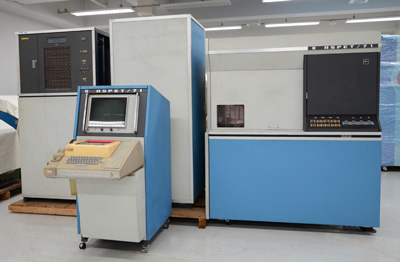

- Home >
- Artifacts of IP Heritage >
- 2011 >
- ASPET/71
ASPET/71

| Manufactured in | 1971 |
|---|---|
| Manufactured by | Tokyo Shibaura Electric Co., Ltd. (Now, TOSHIBA Corporation) and Electrotechnical Laboratory (Now, National Institute of Advanced Industrial Science and Technology) |
| Owner | The National Museum of Nature and Science, Tokyo |
| Location of historical materials | The National Museum of Nature and Science, Tokyo 4-1-1 Amakubo, Thukuba-shi, Ibaraki 305-0005, Japan |
| Visitor information | Not open to the public (visit by appointment only) |
| Contact | Department of Science & Engineering webmaster@kahaku.go.jp http://www.kahaku.go.jp/ |
ASPET/71 is a super-high performance optical character reader developed based on a new visual pattern recognition theory by the joint project of Electrotechnical Laboratory (ETL, Now, National Institute of Advanced Industrial Science and Technology) and Toshiba.
Taizo Iijima of ETL elucidated the fact that the blure of the Gaussian type originally accompanied the image caught by the vision and established a united basic theoretical system concerning the visual pattern recognition in 1965 in advance of the world.
The research and development project of a super-high performance computer was begun in 1966 by the Ministry of International Trade and Industry. The project aimed at the development of an original character reader in the project and succeeded in the development of super-high performance OCR "ASPET/71" in 1971. In the design of this OCR, above-mentioned basic theoretical system and "Multiple Simularity Method" having been newly invented by IIjima were adopted and the reading of the low quality character thought to be impossible till then had become possible for the first time. Spatial networks to process information in parallel with analog elements were also developed. This made possible high speed processing based on the above mentioned system, and realized very high-speed reading capability of 2,000 alphanumeric characters per second.
This work established the systematic performance improvement methodology of pattern recognition and greatly contributed to rapid progress of OCR technology.
Taizo Iijima of ETL elucidated the fact that the blure of the Gaussian type originally accompanied the image caught by the vision and established a united basic theoretical system concerning the visual pattern recognition in 1965 in advance of the world.
The research and development project of a super-high performance computer was begun in 1966 by the Ministry of International Trade and Industry. The project aimed at the development of an original character reader in the project and succeeded in the development of super-high performance OCR "ASPET/71" in 1971. In the design of this OCR, above-mentioned basic theoretical system and "Multiple Simularity Method" having been newly invented by IIjima were adopted and the reading of the low quality character thought to be impossible till then had become possible for the first time. Spatial networks to process information in parallel with analog elements were also developed. This made possible high speed processing based on the above mentioned system, and realized very high-speed reading capability of 2,000 alphanumeric characters per second.
This work established the systematic performance improvement methodology of pattern recognition and greatly contributed to rapid progress of OCR technology.
